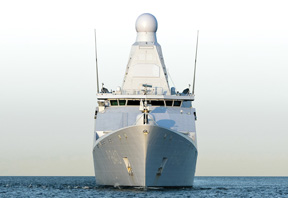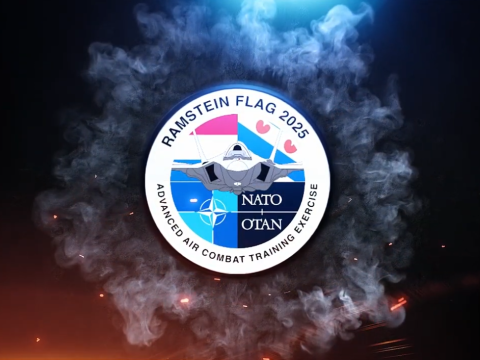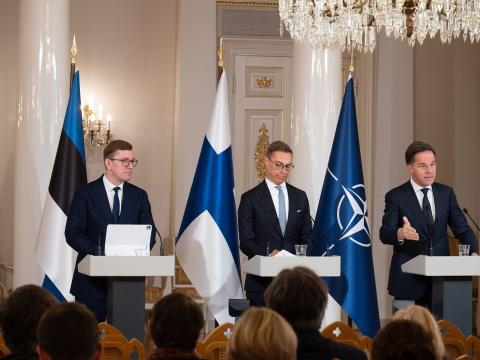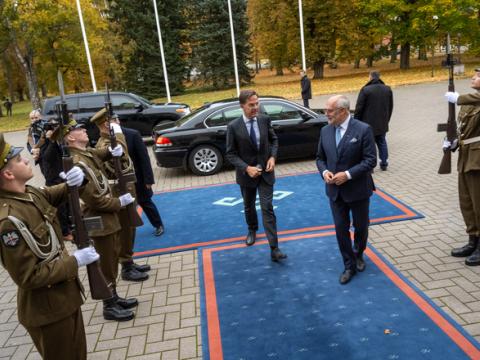Dutch Navy Sails Into New Era, New Challenges
 |
|
| The Holland features the I-Mast 400 from Thales Nederland, a new comminications mast that can be built modularly, saving time and money in the shipyard. The 52-ton, 370-foot radio mast also is designed so that most equipment maintenance can be conducted inside the mast structure, reducing the number of crew needed for this work. |
The Dutch Navy is building a new class of oceangoing patrol vessels designed to meet the range of missions expected in the decades ahead. These concerns include illicit trafficking, drug smuggling, human trafficking, weapons smuggling and piracy.
The first of the four ships in the Holland class, the HNLMS Holland, was commissioned in July 2012. The ship requires only 50 crew members, has a weight of 357 tons—enabling operations in the Indian Ocean and the Caribbean, and has space for a pair of Fast Raiding Interception and Special Forces Craft (FRISC) and an NH-90 helicopter. It also has enough room onboard to support noncombatant humanitarian operations when needed.
Prior to the development of the Holland class of ships, the Dutch naval fleet was composed primarily of destroyers, frigates, submarines and a range of support vessels designed primarily for fleet-to-fleet combat.
The Netherlands’ naval requirements began to evolve as the civil war in Somalia led to an increase in piracy in international waters in the Indian Ocean. As the Netherlands focused its resources on combatting pirates, a naval study conducted in 2005 questioned if its existing naval fleet was well suited for this mission. This study resulted in approval for the new oceangoing patrol vessels, according to Vice Adm. Matthieu Borsboom, commander of the Royal Netherlands Navy (Koninklijke Marine, KM), and the highest-ranking military officer in the service.
The Holland-class patrol vessels, with multiple mission profiles, required new design thinking on the part of Dutch naval architects according to Adm. Borsboom.
“If you want to have a big ship like that with so few crew members, you really have to think about logistics, maintenance, operations, tactical, and so the number of crew really drove the innovation,” he outlines.
The Holland takes advantage of recent developments in communications technologies for naval vessels, says the admiral, including the I-Mast 400. This is a new 52-ton, 370-foot radio mast built by Thales Nederland, which carries the latest optical, infrared and air defense sensors, and identification friend-or-foe (IFF) communications equipment. The mast is designed to allow the crew to perform all maintenance tasks from inside the structure.
“This is a really big feature,” Adm. Borsboom explains, “because it reduces the number of crew needed for support, and it reduces costs.”
The mast can be built, configured and tested in a separate facility from the rest of the ship. Final installation of the I-Mast took take place in only two and a half hours, Adm. Borsboom explains. Building and installing the mast using these new techniques helped cut six months from the Holland’s shipyard construction schedule, further reducing costs.
Reducing cost is essential, especially with the recent push of global austerity measures to control spending, acknowledges the admiral. Funding is a top concern for U.S. military leaders as well as their counterparts in NATO, he emphasizes.
In the Netherlands, the Dutch military has been asked to cut €1 billion from its most recent fiscal year budget, says Adm. Borsboom. For the Dutch Navy, that will reduce the number of mine hunters from 10 to six. It also will reduce Dutch Navy staff by as much as 30 percent and require reorganizing the remaining personnel.
Even as he deals with spending cuts and the impact on his staff and resources, Adm. Borsboom believes many people understand the need to maintain the Dutch Navy’s edge when it comes to maritime security. “The interdependency in the world’s economy is based on trade,” the admiral notes, adding, “If that’s disturbed, it really affects the economy.”
Piracy in international waters threatens the smooth operation of supply chains upon which large global businesses depend, the admiral elaborates. “The ship is the warehouse,” he says, describing how just-in-time manufacturing processes have eliminated the need to ship components from one place to another prior to final assembly. “If the ship is disturbed, and it could only be one container holding small bits and pieces necessary to construct large apparatus, you see that an entire industry can be flattened, as we saw following the tsumani in Japan.”
The admiral notes that most of the world’s oceanic trade arteries are at the Earth’s equator, at which many of the world’s most impoverished and politically unstable nations are also located. Because of this, Adm. Borsboom believes it is very likely that demands on maritime security will increase, resulting in a concurrent shift in resources to address the problems.
In recent years, criticism has been leveled against the United Nations and other coalition military members for the extent of efforts to combat Somalian piracy. Adm. Borsboom deflects such criticism, saying that the Dutch Navy is part of a number of global military coalitions that are actively working to fight piracy not only in the Indian Ocean but also in other locations.
“We have NATO out there. They are running ‘Ocean Shields’ as an operation. We have the EU [European Union] out there in the fight against piracy. Thirdly, we have the American initiative, CTF-150 [Combined Task Force 150], in which we have other nations contributing” to a sea-based anti-piracy coalition.
Several other large nations not operating under the aegis of these three formal coalitions are also participating actively in anti-piracy efforts. These nations include China, India and Russia.
“That’s interesting,” he notes, “because these task forces work seamlessly together, and we can say that because our ships have been working in these coalitions.” He notes that Dutch naval officers have served rotations as lead commanders in the NATO and EU anti-piracy efforts.
The unrelenting pace of globalization also requires that maritime security be a high priority for security reasons, says Adm. Borsboom. He has conducted talks in Washington and Norfolk, Virginia, with his counterparts from the U.S. Navy, Marine Corps and Coast Guard. He also traveled to Brazil for meetings of the Joint Interagency Task Force South, a coalition of North, Central and South American nations, along with European nations, whose navy and coast guard vessels routinely patrol in the Caribbean. His meetings also coincided with final sea trials In Key West, Florida, for the Holland, whose first mission will take the newly commissioned patrol vessel into the waters off the Netherlands Antilles in the Caribbean.
“This is a very close collaboration, we understand each other. We appreciate how professional the Coast Guard is, and this a very fruitful cooperation. With the Navy, it’s a longer relationship. We have been working with the Navy for a long time, including mine hunters, submarines and frigates. We were in [Navy] carrier groups during the Cold War. We’ve worked with the navies of Greenland and Iceland and the United Kingdom,” he points out.




Comments